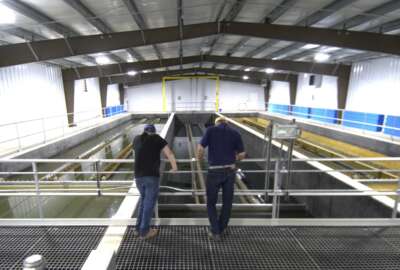Hubbard Radio Washington DC, LLC. All rights reserved. This website is not intended for users located within the European Economic Area.
That office-building boiler will soon be scrap metal
A new rule from the Energy Department means the eventual end of gas and oil to heat new and renovated federal buildings.
A new rule from the Energy Department means the eventual end of gas and oil to heat new and renovated federal buildings. And, DOE officials believe, the rule will save tens of millions of dollars. For details on the Federal Drive with Tom Temin, Federal News Network Deputy Editor talked with David Smedick, the federal policy manager for the carbon-free buildings program at the Rocky Mountain Institute.
Interview Transcript:
David Smedick Yeah, absolutely. We’re really excited about it. So we do think it’s a big deal. And I think a lot of people across the industry recognize the importance of this role, coming down from DOE and the [Federal Energy Management Program (FEMP)]office. And so, we believe a key pillar of the federal building decarbonization process here. So under the sustainability plan, from this administration, you’re really looking at having net zero buildings across the federal portfolio over the next couple of decades. And this is one of the key pieces when you’re dealing with on site emissions, you need to zero those out. And that’s essentially what this role does for new construction on major renovations. It partners really well with, say, the building performance standard for federal buildings with the existing energy efficiency rules. This is a new way for the federal government to move forward and making sure that those on site fossil fuel emissions are eliminated from getting that portfolio of new construction, major renovations as we move forward.
Jared Serbu And the requirement is by 2030. And given the pace at which the government moves on a lot of things, how realistic is that? Given what we understand about their ability to implement clean energy projects, etc.
David Smedick Yeah, we think this one is doable. It’s been part of the law that was passed in 2007, where these rules and those targets, with the years implemented here. So looking back at over the next couple of years, the new projects that are coming online need to hit the 90% reduction mark, but then that that full fossil free, key marker goes into effect for 2030 and moving forward. And what we’re seeing is that, especially by 2030 and really now, your new construction projects can hit these targets. I think that it’s smart the rules that were finalized have those pieces where you can petition for if you’re really struggling with technical and feasibility, whether it’s a space construction or there’s the technology really isn’t there. And you can prove that to DOE, you can move forward with the project, just working with the agency to work around those pieces. But the heat pump technologies that are out there, which is the big ticket for this, really, it’s about those, HVAC systems. You have efficient all electric options on the market now, that we think you can be building these buildings with. And that’s what I think is really important. So by 2030, from our perspective, you really should be good to go. And it’s going to be a really exciting time because it’s going to really help move that market forward as well as lead by example policy.
Jared Serbu Are some agencies going to run into situations where they’re just constrained by what’s locally available where there really is no clean energy available from the grid.
David Smedick Well, so this role in particular is really focused on the on site emissions. And so what that means is when you’re combusting in a fuel on site, whether that’s for the heating, whether it’s for cooking, or hot water. So when it comes to the grid, there are other policies in place from the federal government and standards and processes they’re working on to clean the grid and make sure that you’re procuring it correctly. But this regulation is really about those on site emissions associated with the equipment that’s in moveable onsite kind of work there. So your HVAC, your hot water cooking and clothes drying you may have that would be fossil fuel powered in the past, just making sure that’s all efficient electric equipment.
Jared Serbu Talk a bit about the ways in which this might cause some developments outside of the government and spur innovation that might affect the private sector as well.
David Smedick Yeah, that’s one of the reasons we’re really excited about it. On the face of it, having more buildings from the federal government, be all electric is really important for a lot less air pollution, for making sure that you have cost effective strategies that use efficiency on that side for electrification on the building itself. But as you just noted, the the broader impact of this, the federal government’s purchasing power is really significant. And that’s something we’re excited about. And this is indicating to the market that this is the direction that we can be moving and we should be moving, and we need to be moving across the market. So whether that’s private sector public buildings as well. And that’s something that, here at RMI, we’re really leaning into and think there’s a big opportunity for with the federal government taking this move, other government entities and public buildings can be moving in this direction as well. So smart use of taxpayer dollars, right here dollars, whatever you want to call it. Public money can be here for efficient electric buildings on the new construction and major innovation side. This policy should be a waterfall moment for that. And we really think that it will signal to the manufacturers of these clean energy and clean technology equipment that you have buyers ready to go now. And this is something that I think they’ll build up to as we talk about that 2030 mark comes forward.
Jared Serbu As you mentioned earlier, this particular rule only applies to new construction and major renovations. One thing we know about the federal government is that there are a lot of old facilities out there. How much of a concern are those, and are there other efforts that get at those issues?
David Smedick Yeah, definitely. So the other policy I mentioned, which is exciting, is the federal building performance standard. So this was an initiative that four out of one of, the president’s earlier executive orders, making sure that we have a decarbonized federal government. Is this kind of the tagline on it? There’s lots of details within there, but that federal building performance standard is essentially saying, that for existing buildings, we’re going to create a pathway of renovation moving forward and have specific targets by which you need to reduce your energy consumption associated with onsite fuels. And so, that’s been going on for I think it was released about a year and a half ago, maybe two years. And so the agencies are out there kind of putting their plans together for, I think it’s about 30% or so, because their existing portfolio needs to hit zero on site emission renovation work by 2030 or so or 2035, I don’t remember the exact date to be honest, so we can look that up. But, that building performance standard is something that the White House has been has pulled together in moving forward and working with agencies to implement. So when it comes those older facilities that federal building performance standard is, I think really going to take those moving forward. They work really nicely and pair together this new construction and then that retrofit standard.
Jared Serbu And I guess the last thing I’d ask you, David, is what do you see as the challenges toward implementation here? You said there’s some waivers and some workarounds for agencies that end up really struggling with this. What do you think those struggles are going to be the extent they come up.
David Smedick Yeah I think some of those space constraints at different times. I think that’s when you do have some of the older buildings that may be going through a major renovation. Some of the technologies are a little different. So, when you’re plotting out how you’re going to actually physically install something in a space, you’re going to need to evaluate, ok, do I have the right set up here? Is it going to have the right airflow, associated with the HVAC equipment that’s needed for this new efficient electrical equipment versus what you maybe had beforehand? And so would that require a new structural change to the renovation? Or is this a way that I could petition and understand that we just technically can’t do that, because it is not part of our plans or something. So I think those are some of the struggles that will run into and we’ll see through the petition process. I think a lot more of what the the actual on the ground issues are. I think that’s where we’re going to see what buildings are running into. But I’d also say that I think the FEMP office has really kind of administering this and pushing the rule out. They’re going to have implementation guidance here coming out. They don’t have an exact date, but that’s, I think, really going to drive a lot of information for folks out into the world of, ok, what is FEMP anticipating some of the issues are going to be in, how are they going to work with the agencies to make sure that those issues are either overcomable and they can get the solution implemented, or if they need to rework their implementation guidance a little bit and understand what the flexibility needs are for folks so that implementation guidance, once it comes out from FEMP, I think is going to answer a lot of questions that folks have. At least that’s my hope.
Copyright © 2024 Federal News Network. All rights reserved. This website is not intended for users located within the European Economic Area.
Jared Serbu
Jared Serbu is deputy editor of Federal News Network and reports on the Defense Department’s contracting, legislative, workforce and IT issues.
Follow @jserbuWFED
Related Stories
Federal buildings board: Agencies can save billions by shedding ‘vastly underutilized’ office space
Related Stories
-
GSA doubles down on shedding federal office space. The next administration may alter its plans Facilities/Construction
-
Safeguarding critical infrastructure: Addressing threats to the water sector Facilities/Construction





